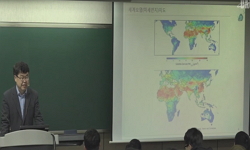목적: 대기오염 물질이 전신 염증(systemic inflammation) 상태를 유발시킴으로써 심혈관 건강에 부정적인 영향을 미친다는 것은 잘 알려져 있으나, 항염증 효과가 있는 약물이 대기오염 노출, 특...
http://chineseinput.net/에서 pinyin(병음)방식으로 중국어를 변환할 수 있습니다.
변환된 중국어를 복사하여 사용하시면 됩니다.
- 中文 을 입력하시려면 zhongwen을 입력하시고 space를누르시면됩니다.
- 北京 을 입력하시려면 beijing을 입력하시고 space를 누르시면 됩니다.
https://www.riss.kr/link?id=T16627544
- 저자
-
발행사항
서울 : 연세대학교 대학원, 2023
- 학위논문사항
-
발행연도
2023
-
작성언어
한국어
-
주제어
허혈성심질환 ; 대기오염 ; 고혈압 ; 스타틴 ; ischemic heart disease ; air pollution ; hypertension ; statins
-
발행국(도시)
서울
-
기타서명
Effect modification of the association between Air pollution and Ischemic heart disease by Statin use in Hypertensive patients
-
형태사항
vii, 101장 : 삽화(일부천연색) ; 26 cm
-
일반주기명
지도교수: 조재림
-
UCI식별코드
I804:11046-000000545407
- 소장기관
-
0
상세조회 -
0
다운로드
부가정보
국문 초록 (Abstract)
대기오염 물질이 전신 염증(systemic inflammation) 상태를 유발시킴으로써 심혈관 건강에 부정적인 영향을 미친다는 것은 잘 알려져 있으나, 항염증 효과가 있는 약물이 대기오염 노출, 특히 단기노출에 의한 심혈관계 영향을 감소시킬 수 있는지에 대한 연구는 미비한 실정이다. 이에 본 연구에서는 고혈압환자에서 항염증 효과가 있다고 알려진 스타틴의 사용이 대기오염 단기노출로 인한 허혈성 심질환 입원 위험을 감쇠시키는지 확인하고자 한다.
연구방법:
국민건강보험공단의 맞춤형 자료를 통해 서울지역의 허혈성심질환으로 입원한 대상자들의 의료 이용자료를 획득하여 시간-층화 환자-교차연구설계를 수행하였다. 서울지역의 입자의 지름이 10㎛ 이하인 미세먼지(PM10), 2.5㎛ 이하인 초미세먼지(PM2.5), 아황산가스(SO2), 이산화질소(NO2), 일산화탄소(CO) 그리고 오존(O3)의 일일 평균 농도는 에어코리아에서 획득하였다. 허혈성심질환 입원일부터 입원일 7일전까지의 농도를 사용하였다. 2018-2019년 사이 허혈성심질환으로 인한 첫 응급실 입원을 식별하였고, 이 중 입원 전 3년 동안 고혈압으로 의료이용을 한 환자만을 대상으로 하였다. 허혈성심질환 입원 1년 전 약제 처방이력을 기반으로 안지오텐신 수용체 차단제(ARB) 단일제 복용군과 ARB 스타틴 복합제 복용군을 식별하여 일대일 비교를 수행하였다. 공휴일과 기상 변수를 보정하여 두 그룹 각각에서 조건부 로지스틱 회귀 분석을 수행하였다. 허혈성심질환 입원 위험은 각 대기 오염 물질의 1 단위 증가당 교차비(Odds ratio, OR)와 95% 신뢰 구간(95% Confidence interval, CI)으로 표현되다. 두 그룹의 OR 간 차이의 통계적 유의성은 p for interaction 공식을 통해 산출하였다.
결과:
본 연구에 총 11,623명이 포함되었다.
입원일부터 하루 전 평균 PM10 농도의 10 μg/m³ 증가는 ARB 단일제 복용군에서 허혈성심질환 입원 위험 증가와 관련이 있었으나(OR, 1.005; 95% CI, 0.994-1.017), ARB 스타틴 복합제 복용군(0.964; 0.930-0.998)에서 그 위험이 감소한 것으로 나타났다(p for interaction=0.03). PM2.5의 10 μg/m³ 증가는 스타틴 복합제 복용군(OR, 0.946; 95% CI, 0.900-0.995)에서 허혈성심질환 위험 감소와 관련이 있었음(OR, 0.946; 95% CI, 0.900-0.995)
결론: 본 연구 결과는 스타틴 병용 요법이 고혈압 환자의 허혈성심질환의 위험에 대한 대기오염 노출의 단기적 영향을 보호할 수 있음을 시사한다.
목적:
대기오염 물질이 전신 염증(systemic inflammation) 상태를 유발시킴으로써 심혈관 건강에 부정적인 영향을 미친다는 것은 잘 알려져 있으나, 항염증 효과가 있는 약물이 대기오염 노출, 특히 단기노출에 의한 심혈관계 영향을 감소시킬 수 있는지에 대한 연구는 미비한 실정이다. 이에 본 연구에서는 고혈압환자에서 항염증 효과가 있다고 알려진 스타틴의 사용이 대기오염 단기노출로 인한 허혈성 심질환 입원 위험을 감쇠시키는지 확인하고자 한다.
연구방법:
국민건강보험공단의 맞춤형 자료를 통해 서울지역의 허혈성심질환으로 입원한 대상자들의 의료 이용자료를 획득하여 시간-층화 환자-교차연구설계를 수행하였다. 서울지역의 입자의 지름이 10㎛ 이하인 미세먼지(PM10), 2.5㎛ 이하인 초미세먼지(PM2.5), 아황산가스(SO2), 이산화질소(NO2), 일산화탄소(CO) 그리고 오존(O3)의 일일 평균 농도는 에어코리아에서 획득하였다. 허혈성심질환 입원일부터 입원일 7일전까지의 농도를 사용하였다. 2018-2019년 사이 허혈성심질환으로 인한 첫 응급실 입원을 식별하였고, 이 중 입원 전 3년 동안 고혈압으로 의료이용을 한 환자만을 대상으로 하였다. 허혈성심질환 입원 1년 전 약제 처방이력을 기반으로 안지오텐신 수용체 차단제(ARB) 단일제 복용군과 ARB 스타틴 복합제 복용군을 식별하여 일대일 비교를 수행하였다. 공휴일과 기상 변수를 보정하여 두 그룹 각각에서 조건부 로지스틱 회귀 분석을 수행하였다. 허혈성심질환 입원 위험은 각 대기 오염 물질의 1 단위 증가당 교차비(Odds ratio, OR)와 95% 신뢰 구간(95% Confidence interval, CI)으로 표현되다. 두 그룹의 OR 간 차이의 통계적 유의성은 p for interaction 공식을 통해 산출하였다.
결과:
본 연구에 총 11,623명이 포함되었다.
입원일부터 하루 전 평균 PM10 농도의 10 μg/m³ 증가는 ARB 단일제 복용군에서 허혈성심질환 입원 위험 증가와 관련이 있었으나(OR, 1.005; 95% CI, 0.994-1.017), ARB 스타틴 복합제 복용군(0.964; 0.930-0.998)에서 그 위험이 감소한 것으로 나타났다(p for interaction=0.03). PM2.5의 10 μg/m³ 증가는 스타틴 복합제 복용군(OR, 0.946; 95% CI, 0.900-0.995)에서 허혈성심질환 위험 감소와 관련이 있었음(OR, 0.946; 95% CI, 0.900-0.995)
결론: 본 연구 결과는 스타틴 병용 요법이 고혈압 환자의 허혈성심질환의 위험에 대한 대기오염 노출의 단기적 영향을 보호할 수 있음을 시사한다.
다국어 초록 (Multilingual Abstract)
cardiovascular health via systemic inflammation. However, there is little evidence
on whether medications with anti-inflammatory properties reduce the
cardiovascular effect of particulate matter, particularly the short-term effect. This
study aimed to investigate whether the use of statin (which has anti-inflammatory
properties) attenuates the short-term effect of particulate matter exposures on the
risk of ischemic heart disease (IHD) admission in patients with hypertension.
Methods & Materials: For this time-stratified case-crossover study, the
National Health Insurance Service provided healthcare utilization data of patients
who were admitted for IHD in Seoul, Korea. Daily average concentrations of
particulate matter (PM) with aerodynamic diameters of ≤10μm (PM10) and
≤2.5μm (PM2.5), Sulfur dioxide (SO2), Ozon (O3), Nitrogen dioxide (NO2),
and Carbon monoxide (CO) in Seoul were obtained from Air Korea. The
concentration from the day of ischemic heart disease admission to 7 days before
the hospitalization day was used. We identified first admissions for IHD (via
emergency department) in 2018-2019. Out of these, only patients with any visits
for hypertension for three years prior to the admissions were considered. Based on
prescription data one year prior to the IHD admissions, we identified individuals
on angiotensin receptor blocker (ARB) single-pill and those on combined ARB and
statins (the statin combination group) to carry out a head-to-head comparison. A
conditional logistic regression analysis was performed in each of these two groups,
adjusting for national holidays and meteorological variables. The risk of IHD
admission was expressed as an odds ratio (OR) per 10 μg/m³ increase in each air
pollutant and its 95% confidence interval (95% CI). Significant of difference in the
risks between the two drug groups was tested (presented as a p for interaction).
Results: A total of 11,623 IHD patients with history of hypertension were
included. A 10 μg/m³ increase in PM10 (one day prior to an IHD admission) was
associated with an increased risk of IHD admission in the ARB single-pill group
(OR, 1.005; 95% CI, 0.994-1.017), but with a decreased risk in the statin
combination group (0.964; 0.930-0.998) (p for interaction=0.03). A 10 μg/m³ increase
in PM2.5 (one day prior to an IHD admission) was associated with a decreased
risk of IHD admission in the statin combination group (OR, 0.946; 95% CI,
0.900-0.995), but with an increased risk in the ARB single-pill group (1.003;
0.988-1.019) (p for interaction=0.03).
Conclusions: Our findings suggest that statin combination therapy may be
protective of the short-term effects of particulate matter exposures on the risk of
IHD in patients with hypertension.
Objectives: Air pollution, such as particulate matter, exposures adversely affect cardiovascular health via systemic inflammation. However, there is little evidence on whether medications with anti-inflammatory properties reduce the cardiovascular eff...
Objectives: Air pollution, such as particulate matter, exposures adversely affect
cardiovascular health via systemic inflammation. However, there is little evidence
on whether medications with anti-inflammatory properties reduce the
cardiovascular effect of particulate matter, particularly the short-term effect. This
study aimed to investigate whether the use of statin (which has anti-inflammatory
properties) attenuates the short-term effect of particulate matter exposures on the
risk of ischemic heart disease (IHD) admission in patients with hypertension.
Methods & Materials: For this time-stratified case-crossover study, the
National Health Insurance Service provided healthcare utilization data of patients
who were admitted for IHD in Seoul, Korea. Daily average concentrations of
particulate matter (PM) with aerodynamic diameters of ≤10μm (PM10) and
≤2.5μm (PM2.5), Sulfur dioxide (SO2), Ozon (O3), Nitrogen dioxide (NO2),
and Carbon monoxide (CO) in Seoul were obtained from Air Korea. The
concentration from the day of ischemic heart disease admission to 7 days before
the hospitalization day was used. We identified first admissions for IHD (via
emergency department) in 2018-2019. Out of these, only patients with any visits
for hypertension for three years prior to the admissions were considered. Based on
prescription data one year prior to the IHD admissions, we identified individuals
on angiotensin receptor blocker (ARB) single-pill and those on combined ARB and
statins (the statin combination group) to carry out a head-to-head comparison. A
conditional logistic regression analysis was performed in each of these two groups,
adjusting for national holidays and meteorological variables. The risk of IHD
admission was expressed as an odds ratio (OR) per 10 μg/m³ increase in each air
pollutant and its 95% confidence interval (95% CI). Significant of difference in the
risks between the two drug groups was tested (presented as a p for interaction).
Results: A total of 11,623 IHD patients with history of hypertension were
included. A 10 μg/m³ increase in PM10 (one day prior to an IHD admission) was
associated with an increased risk of IHD admission in the ARB single-pill group
(OR, 1.005; 95% CI, 0.994-1.017), but with a decreased risk in the statin
combination group (0.964; 0.930-0.998) (p for interaction=0.03). A 10 μg/m³ increase
in PM2.5 (one day prior to an IHD admission) was associated with a decreased
risk of IHD admission in the statin combination group (OR, 0.946; 95% CI,
0.900-0.995), but with an increased risk in the ARB single-pill group (1.003;
0.988-1.019) (p for interaction=0.03).
Conclusions: Our findings suggest that statin combination therapy may be
protective of the short-term effects of particulate matter exposures on the risk of
IHD in patients with hypertension.
목차 (Table of Contents)
- 국 문 요 약
- I. 서론
- 1. 연구 배경 및 필요성
- 1.1. 대기오염
- 1.2. 허혈성 심질환
- 국 문 요 약
- I. 서론
- 1. 연구 배경 및 필요성
- 1.1. 대기오염
- 1.2. 허혈성 심질환
- 1.3. 고혈압환자에서의 대기오염 노출과 허혈성 심질환 발생 위험
- 1.4. 고혈압 환자의 약물 복용
- 2. 연구 목표
- II. 재료 및 방법
- 1. 연구 설계
- 2. 허혈성심질환 응급실 입원
- 2.1. 허혈성심질환 입원 자료
- 2.2. 허혈성 심질환 응급실 입원의 정의
- 3. 고혈압환자과 항고혈압제 복용군
- 4. 대기오염 자료
- 5. 기상 자료
- 6. 통계 분석 방법
- 7. 민감도 분석
- 7.1. 대상자 재정의
- 7.2. 결과변수 재정의 - 급성심근경색
- 8. 통계 분석 프로그램
- 9. 연구 윤리
- III. 연구 결과
- 1. 연구 대상자의 특성
- 2. 서울 지역 대기오염 농도
- 3. 서울 지역 온도 및 상대습도
- 4. 대기오염과 허혈성 심질환 응급실 입원
- 1) 고혈압군의 응급실 입원 위험
- 2) 고혈압 약물복용군의 응급실 입원 위험
- 5. 항고혈압제 복용에 따른 효과변경
- 6. 민감도 분석
- 6.1. 대상자 재정의
- 2) 결과변수 재정의 – 급성심근경색
- IV. 고찰
- V. 결론
- 참 고 문 헌
- 부록
- ABSTRACT












